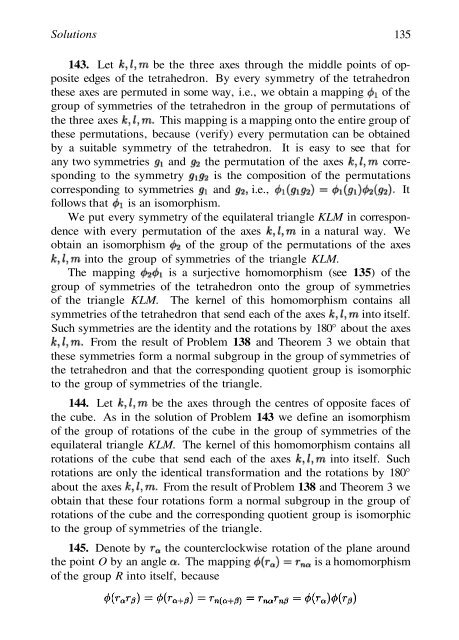Abel's theorem in problems and solutions - School of Mathematics
Abel's theorem in problems and solutions - School of Mathematics
Abel's theorem in problems and solutions - School of Mathematics
You also want an ePaper? Increase the reach of your titles
YUMPU automatically turns print PDFs into web optimized ePapers that Google loves.
Solutions<br />
135<br />
143. Let be the three axes through the middle po<strong>in</strong>ts <strong>of</strong> opposite<br />
edges <strong>of</strong> the tetrahedron. By every symmetry <strong>of</strong> the tetrahedron<br />
these axes are permuted <strong>in</strong> some way‚ i.e.‚ we obta<strong>in</strong> a mapp<strong>in</strong>g <strong>of</strong> the<br />
group <strong>of</strong> symmetries <strong>of</strong> the tetrahedron <strong>in</strong> the group <strong>of</strong> permutations <strong>of</strong><br />
the three axes This mapp<strong>in</strong>g is a mapp<strong>in</strong>g onto the entire group <strong>of</strong><br />
these permutations‚ because (verify) every permutation can be obta<strong>in</strong>ed<br />
by a suitable symmetry <strong>of</strong> the tetrahedron. It is easy to see that for<br />
any two symmetries <strong>and</strong> the permutation <strong>of</strong> the axes correspond<strong>in</strong>g<br />
to the symmetry is the composition <strong>of</strong> the permutations<br />
correspond<strong>in</strong>g to symmetries <strong>and</strong> i.e.‚ It<br />
follows that is an isomorphism.<br />
We put every symmetry <strong>of</strong> the equilateral triangle KLM <strong>in</strong> correspondence<br />
with every permutation <strong>of</strong> the axes <strong>in</strong> a natural way. We<br />
obta<strong>in</strong> an isomorphism <strong>of</strong> the group <strong>of</strong> the permutations <strong>of</strong> the axes<br />
<strong>in</strong>to the group <strong>of</strong> symmetries <strong>of</strong> the triangle KLM.<br />
The mapp<strong>in</strong>g is a surjective homomorphism (see 135) <strong>of</strong> the<br />
group <strong>of</strong> symmetries <strong>of</strong> the tetrahedron onto the group <strong>of</strong> symmetries<br />
<strong>of</strong> the triangle KLM. The kernel <strong>of</strong> this homomorphism conta<strong>in</strong>s all<br />
symmetries <strong>of</strong> the tetrahedron that send each <strong>of</strong> the axes <strong>in</strong>to itself.<br />
Such symmetries are the identity <strong>and</strong> the rotations by 180° about the axes<br />
From the result <strong>of</strong> Problem 138 <strong>and</strong> Theorem 3 we obta<strong>in</strong> that<br />
these symmetries form a normal subgroup <strong>in</strong> the group <strong>of</strong> symmetries <strong>of</strong><br />
the tetrahedron <strong>and</strong> that the correspond<strong>in</strong>g quotient group is isomorphic<br />
to the group <strong>of</strong> symmetries <strong>of</strong> the triangle.<br />
144. Let be the axes through the centres <strong>of</strong> opposite faces <strong>of</strong><br />
the cube. As <strong>in</strong> the solution <strong>of</strong> Problem 143 we def<strong>in</strong>e an isomorphism<br />
<strong>of</strong> the group <strong>of</strong> rotations <strong>of</strong> the cube <strong>in</strong> the group <strong>of</strong> symmetries <strong>of</strong> the<br />
equilateral triangle KLM. The kernel <strong>of</strong> this homomorphism conta<strong>in</strong>s all<br />
rotations <strong>of</strong> the cube that send each <strong>of</strong> the axes <strong>in</strong>to itself. Such<br />
rotations are only the identical transformation <strong>and</strong> the rotations by 180°<br />
about the axes From the result <strong>of</strong> Problem 138 <strong>and</strong> Theorem 3 we<br />
obta<strong>in</strong> that these four rotations form a normal subgroup <strong>in</strong> the group <strong>of</strong><br />
rotations <strong>of</strong> the cube <strong>and</strong> the correspond<strong>in</strong>g quotient group is isomorphic<br />
to the group <strong>of</strong> symmetries <strong>of</strong> the triangle.<br />
145. Denote by the counterclockwise rotation <strong>of</strong> the plane around<br />
the po<strong>in</strong>t O by an angle The mapp<strong>in</strong>g is a homomorphism<br />
<strong>of</strong> the group R <strong>in</strong>to itself‚ because

















